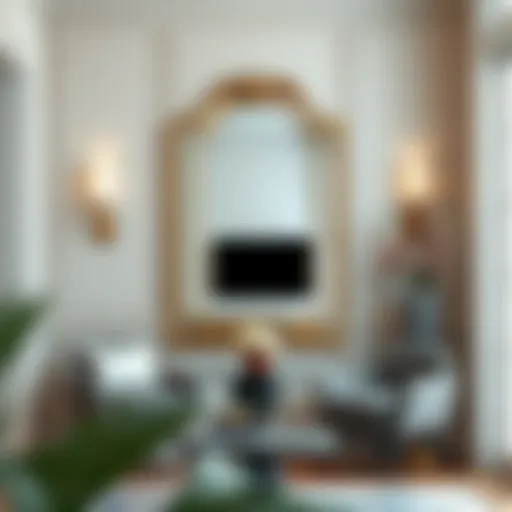Enhancing Interior Design with Real Artificial Flowers

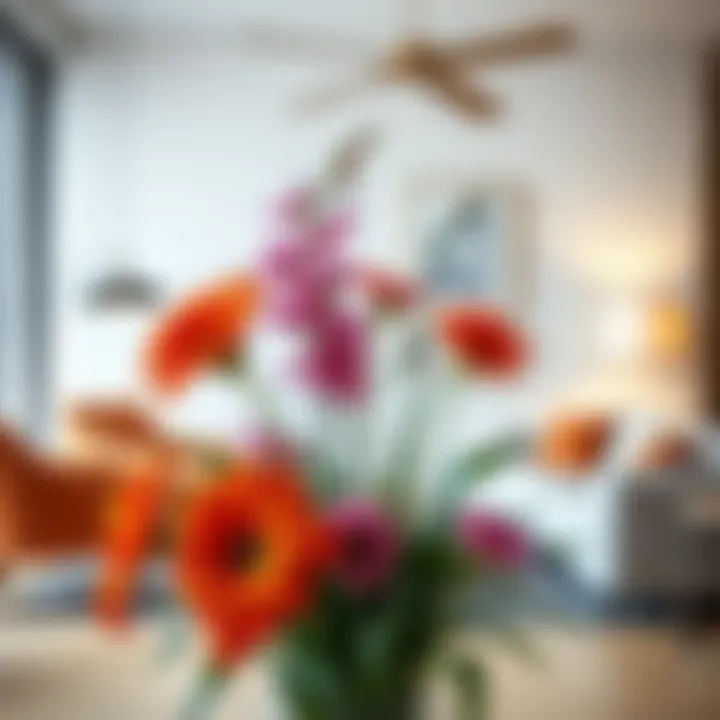
Intro
The ever-evolving world of interior design invites a medley of styles, colors, and textures into our homes. Amidst this vibrant landscape, real artificial flowers emerge as a subtle yet significant player. While their natural counterparts have held a firm grip on the aesthetic appeal, the rising demand for sustainable decor options has unearthed a plethora of opportunities for real artificial flowers. These beautiful creations not only breathe life into a space but also offer a practical solution to those who want the charm of blooming flora without the associated upkeep.
Adopting artificial flora in interior design isn’t merely about mimicking the look of real flowers, but it’s about enhancing the overall ambiance of a space. In this exploration, we will discuss why these faux blossoms have notably carved a niche in the contemporary design scene, how they align with emerging trends, and how to select the perfect pieces that resonate with your decor ethos.
Design Trends
Current Trends in Furniture Styles
Interior design is a reflection of evolving tastes. More homeowners lean towards versatile, adaptable pieces that can harmonize with any decor. This trend has provided fertile ground for incorporating real artificial flowers into overall design themes.
- Scandinavian Minimalism: Clean lines and understated elegance often use soft textures. Here, real artificial flowers can serve as soft accents, creating a gentle contrast against the simplicity of furniture.
- Bohemian Eclectic: A flair for the unconventional can find balance with colorful artificial flowers. Think vibrant arrangements that infuse energy into an otherwise laid-back setup.
- Modern Industrial: The rugged charm of exposed brick and metal fixtures can be softened with delicate floral touches, demonstrating how these flowers can juxtapose raw materials.
How to Incorporate Trends into Your Space
Integrating real artificial flowers into modern design trends requires a level of strategic thought. Here are several ways to achieve this:
- Accent Pieces: Place arrangements on side tables, bookshelves, or windowsills to create pockets of interest.
- Layering Textures: Combine different types of faux flowers with various materials like glass vases or ceramic pots for depth.
- Seasonal Switch-Ups: Changing floral arrangements by season can keep the design fresh. For instance, warm tones in fall or pastel shades in spring can reflect the natural calendar without the maintenance hassle.
"Real artificial flowers hold the power to transform a room’s feel entirely, providing charm and character without the burden of care."
Buying Guides
Choosing the right artificial flowers can feel daunting given the vast array available. However, making informed choices enhances the overall success of your decor.
Choosing the Right Flowers for Different Rooms
- Living Room: Opt for larger arrangements that can become focal points — think oversized blooms in bold colors.
- Kitchen: Smaller clusters or single-stems can liven up countertops without taking over the space.
- Bathroom: Mini arrangements work wonders in smaller areas and can create a refreshing ambiance.
Tips for Assessing Quality and Value
When investing in real artificial flowers, keep the following in mind:
- Material Matters: Look for flowers made from high-quality silk or plastic that mimic the texture and hue of real blooms.
- Check for Details: Inspect if the petals and leaves have realistic veining and shading for a more authentic look.
- UV Resistance: If used in sun-drenched spaces, ensure they are UV-resistant to maintain vibrancy over time.
In the end, real artificial flowers offer an engaging avenue to explore the intersection between sustainability and style in interior design. Not just mere replicas of nature, they stand as a testament to creativity and ingenuity in decorating. By weaving these elements into our homes, we create spaces that reflect personal style and thoughtful living.
The Evolution of Artificial Flowers
The journey of artificial flowers from mere imitations to intricate design elements has been nothing short of remarkable. This evolution is significant not just in the context of aesthetic beautification but also in the broader understanding of home decor’s function and purpose. Real artificial flowers play a vital role in enhancing spaces, offering an opportunity to incorporate nature’s beauty without the drawbacks of real blooms. Their development reflects advancements in technology and shifts in consumer perception, making them a staple for interior designers and homeowners alike.
A Brief History
The story of artificial flowers dates back centuries. Initially crafted from fabric and paper, these faux representations primarily served as economical and long-lasting alternatives to natural blooms. In the 19th century, as manufacturing processes advanced, the quality of these flowers improved significantly. Silk flowers became popular among the affluent, reflecting trends in fashion and decor. As a result, these artificial beauties adorned the homes of many, symbolizing both luxury and practicality.
The rise of modern design in the 20th century brought with it a shift in how artificial flowers were regarded. No longer simply viewed as utilitarian items, they began to be appreciated as artistic expressions, aligning closely with interior design trends. Homeowners started to see the potential for artificial flowers not just to brighten up spaces but to convey specific themes and moods.
Technological Advances
Today, the production of real artificial flowers is an exemplary fusion of art and technology. Innovations in materials, such as high-quality plastics and new textile blends, have provided a lifelike appearance previously thought unattainable. With advanced techniques like hand-painting and intricate detailing, some of these flowers hardly distinguishable from real ones.
Manufacturers are now employing methods such as 3D printing, allowing for unique designs that can be tailored to individual preferences. The customization options available today mean that homeowners and designers can select flowers that fit their specific thematic needs and color palettes without worrying about shelf life. Technologies like moisture-resistance and UV protection further ensure these flowers maintain their looks through seasons and trends, making them a practical choice for decorators.
Changing Perceptions
As interior design has evolved, so have the perceptions surrounding artificial flowers. Once dismissed as cheap or inauthentic, they are now embraced for their versatility and endless creative possibilities. This shift is influenced by a growing awareness of sustainability. Many consumers now favor long-lasting decor options that don’t require constant replacement—real artificial flowers fit this bill perfectly.
Moreover, as discussions around allergies and air quality emerge, artificial flowers often come out on top. They provide the aesthetic advantages of flowers without the pollen and other allergens that can trigger discomfort for some individuals. Returning to notions of style, these flowers offer an easy way to adapt decor to seasonal changes or special occasions, reinforcing their relevance in contemporary design.
"Real artificial flowers provide the charm of nature without the upkeep, making them an essential choice for modern interiors."
Overall, the evolution of artificial flowers reflects broader trends in design and consumer desires. As we delve deeper into their attributes and benefits in subsequent sections, it’s clear that these innovations have cemented artificial flowers’ place in the heart of interior design.
Physical Attributes of Real Artificial Flowers
Understanding the physical attributes of real artificial flowers is essential for anyone involved in interior design. These qualities play a pivotal role in how these floral representations can enhance the aesthetics of a space. When selecting artificial flowers, one must pay attention to certain factors that can significantly affect the overall impact of the design.
Material Composition
The material used in crafting real artificial flowers has a direct influence on their durability, look, and feel. Primarily constructed from silk, polyester, or plastic, the choice of material dictates how realistic the flowers appear and how well they withstand the test of time.
- Silk Flowers: Known for their delicate texture and lifelike appearance, silk flowers are often favored for upscale designs. They offer a softness that mimics real blooms, making them a popular choice in homes and businesses alike. However, they can fade when exposed to direct sunlight.
- Polyester Flowers: More affordable and generally more durable than silk, polyester flowers are easier to clean and maintain. While they may lack the finesse of silk, advancements have allowed them to come in an impressive array of designs, making them a versatile option.
- Plastic Flowers: Often seen as lower-end options, plastic flowers have come a long way. Newer plastic varieties resemble real flowers quite well and are especially suitable for outdoor arrangements. They can withstand various weather conditions without losing color or shape.
Each of these materials carries its advantages and disadvantages, making it critical to consider the context in which they will be used.
Realism in Design
The degree of realism in artificial flowers can vary significantly, impacting their effectiveness as decorative elements. A well-designed flower springs from careful attention to detail, such as the intricacies of petal shapes and textures. The aim is to achieve a look that closely mirrors nature.
- Petal Structure: Genuine flowers are multi-layered, and replicating this in artificial design is paramount. Layers that unfurl and have slight deviations create a sense of authenticity. Some artificial flowers even include realistic veins and markings found in true botanical specimens.
- Stems and leaves: The design does not stop at the flowers themselves. The stems should be sturdy yet flexible enough for positioning, while leaves must carry the right hues and textures to enhance the impression of a living plant. If the foliage appears plastic or overly uniform, it can detract from the overall effect.
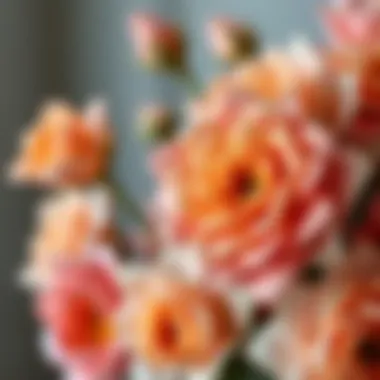
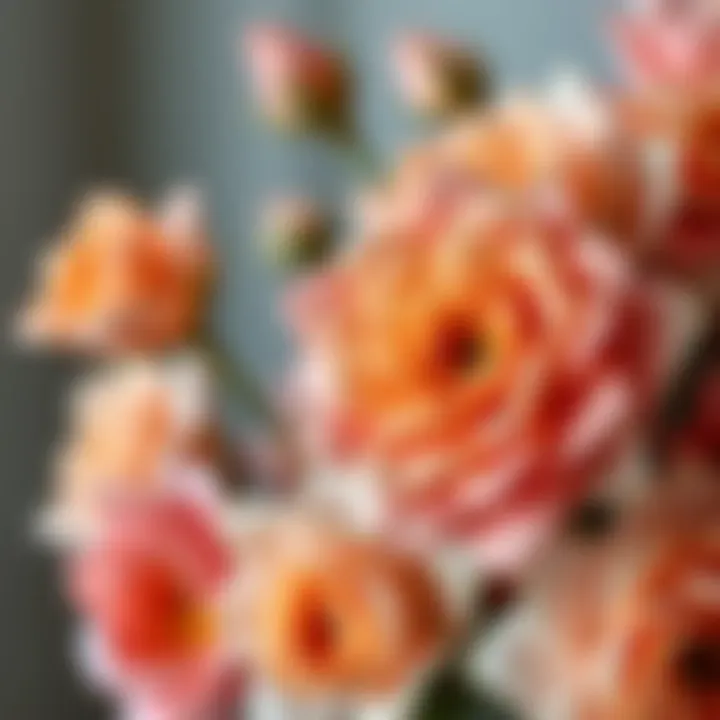
"An artificial flower should never be a mere imitation; it should evoke the lively essence of nature itself."
Color Fidelity
Color fidelity is a crucial aspect of real artificial flowers. How accurately the colors reflect those of natural flowers not only communicates their authenticity but also influences the atmosphere of the space.
- True-to-life Color Matching: Ideally, artificial flowers should boast the rich, vibrant colors found in nature. This involves a careful selection of dyes and finishes that capture the spectrum of hues, including subtle gradients that occur in real blooms.
- Seasonal Adaptation: Some designers might choose various shades based on the season, understanding that the vibrancy of a summer bloom will differ significantly from autumnal or winter arrangements. Utilizing color variations can bring a fresh perspective and more dynamically reflect the changing environment.
Maintaining color integrity is vital. If the flowers lack dimension or their colors appear overly bright or unnatural, they can become a focal point, but for all the wrong reasons.
Benefits of Using Real Artificial Flowers
When contemplating interior design, the impact of decorative elements cannot be understated. Among these elements, real artificial flowers, often hailed as a practical choice, offer a multitude of benefits that can enhance any living space. The significance of such flowers lies not just in their aesthetic appeal but also in their functional advantages. Below, we explore the reasons why incorporating real artificial flowers into your home or workspace is a savvy decision.
Longevity Over Time
One of the primary reasons many homeowners and designers lean toward real artificial flowers is their impressive durability. Unlike natural flowers, which wilt and fade within days, these artificial alternatives can last for several years with minimal wear. The materials used in crafting these blossoms, such as high-quality silk or polyethylene, allow them to retain their shape and color remarkably well.
Consider this: A few well-placed artificial arrangements can bring life to your space without the constant need for replacement. This longevity translates to significant cost savings over time, making them a smart investment. Homeowners appreciate not having to worry about seasonal changes or lamenting over a bouquet that has lost its freshness within a week or two.
"Investing in quality artificial flowers means enjoying their beauty without the heartache of decay."
Minimal Maintenance Requirements
Another appealing aspect of real artificial flowers is their minimal maintenance requirements. Unlike live plants, which demand regular watering, pruning, and sometimes irritating pest control measures, artificial flowers can be placed and forgotten. A simple dusting every now and then is all that is needed to keep them looking pristine.
This characteristic makes them especially advantageous for busy professionals or families who may lack the time or desire for intensive plant care. Furthermore, they do not require sunlight or optimal growing conditions, allowing for flexibility in placement. From dark corners of an office to the center of a stylish dining table, you can enjoy their vibrant appearance without the associated upkeep.
Allergen-Free Decor
For those afflicted with allergies, the presence of natural flowers can trigger sneezes and discomfort. Real artificial flowers serve as a perfect solution, offering all the beauty of fresh blooms without the pollen and allergens that often accompany them. This makes them a preferred choice not just for homes, but also for public spaces, events, and offices where many people gather.
Choosing allergen-free decor means creating an inviting environment where all can feel comfortable. From celebrations to daily meetings, the aesthetic appeal doesn’t need to suffer simply because of environmental sensitivities. In fact, real artificial flowers can add warmth and texture, enhancing the atmosphere without compromising anyone’s health.
Integrating real artificial flowers into your design strategy thus brings with it a wealth of benefits. They are not just ornamental; they are resilient, low-maintenance, and considerate of health concerns, elevating the overall quality of your interior spaces.
Applications in Interior Design
Artificial flowers are not just pretty additions to a room; they play a vital role in interior design. Their use can enhance aesthetics, align with design principles, and improve the functionality of different spaces. Understanding these applications helps homeowners, designers, and enthusiasts make informed choices when incorporating real artificial flowers into their decor.
Enhancing Living Spaces
Creating a warm, inviting atmosphere is crucial in living spaces, and real artificial flowers fit the bill perfectly. They offer a splash of color and texture that can transform an otherwise dull room into a lively environment. For instance, a simple arrangement of vibrant tulips or peonies can breathe life into a neutral-toned lounge, making it more welcoming.
- Diverse Styles: With countless varieties available, you can mix and match to suit your home's individuality.
- Low Maintenance: Unlike real plants, these flowers require no watering, sunlight, or special care, making them ideal for busy households.
- Year-Round Beauty: They provide constant vibrancy, regardless of season changes.
Real artificial flowers allow designers to utilize floral styles that might clash with natural options due to seasonal availabilities. Someone might want daffodils in winter; these flowers make that wish a reality—no waiting for warmer months.
Styling Office Environments
In workplace settings, the design plays a pivotal role in employee satisfaction and productivity. Real artificial flowers can contribute significantly to this atmosphere. They help lift mood, reduce stress, and create a nurturing environment.
- Professional Appearance: Arrangements can enhance the overall professional aesthetic of an office. A well-placed bouquet of lilacs or orchids can convey care and attention to detail.
- Customizable Arrangements: Different flowers can symbolize various brand values or company cultures, such as reliability or comfort. Incorporating specific colors that resonate with the brand can further elevate this expression.
- Improved Air Quality: While they don't purify air like real plants, the presence of flowers can create a positive perception of the environment, promoting well-being.
This strategy in styling boosts not just morale but the overall ambiance, impacting how employees feel at work. A space filled with cheerful faux flowers can help break the monotony of a cubicle, making the workplace more dynamic.
Event Decor Considerations
When planning events, the decor is often as critical as the agenda. Opting for real artificial flowers can reduce stress associated with finding in-season, fresh flowers. They provide versatility and can be tailored to the theme of any occasion.
- Timeliness: You don’t have to worry about last-minute flower arrangements wilting or needing replacements, allowing for more focus on other event details.
- Theme Coordination: Whether for a wedding, corporate function, or a birthday bash, a carefully chosen selection of artificial flowers can help convey the intended emotion. Elegant roses for a wedding or bright daisies for a birthday can set the perfect mood.
- Cost Efficiency: Compared to fresh flowers, real artificial ones often deliver more bang for the buck. They can be reused for multiple events, which is a strategic way to stick to budgets while maintaining quality aesthetics.
Incorporating real artificial flowers into event decorations simplifies logistics and provides liberty in design that natural blooms can't always match. You can experiment and go bold with colors and designs, knowing they’ll maintain their charm throughout the celebration.
"The key to successful interior design lies in creating spaces that reflect the essence of the occupants while ensuring functionality and beauty. Real artificial flowers hold the promise to achieve just that, blending ease of use with a visual appeal that endures."
To sum up, the applications of real artificial flowers in interior design cover a broad spectrum—from enhancing cozy living areas and cultivating professional office spaces to creating breathtaking event environments. By considering these applications, you can navigate your interior design choices more effectively and creatively.
Choosing the Right Real Artificial Flowers
When it comes to interior design, the selection of real artificial flowers plays a pivotal role in creating an inviting atmosphere. It's not just about picking something that looks good; there’s a method to it, one that can enhance the aesthetic and functional aspects of any space. Choosing the right flowers means aligning your selections with personal taste, existing decor, and practical needs.
Identifying Quality
Quality is key. An artificial flower can look appealing at first glance, but a closer inspection reveals its true nature. Look for pieces that have intricate details—veins on petals, varied color shades, and realistic textures. A high-quality flower should replicate nature’s intricacies. Sometimes, these flowers are made from polyester or plastic, which can fade over time, so it's worthwhile to opt for those labeled as UV resistant.
- Feel the Material: The touch can tell you a lot. If it feels cheap, it probably looks cheap too.
- Check for Details: Look for realistic veins and layers. Flowers without these might as well be plastic toys.
- Weight Matters: Heavier flowers often indicate denser, higher quality materials.
Ultimately, investing a bit more in quality can pay dividends in the form of longer-lasting beauty.
Evaluating Design Styles
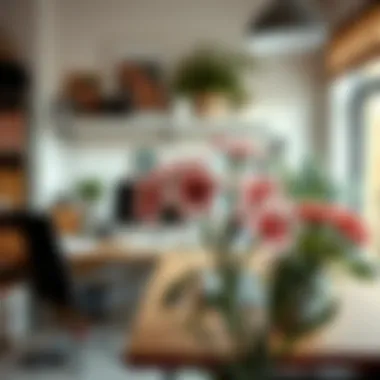
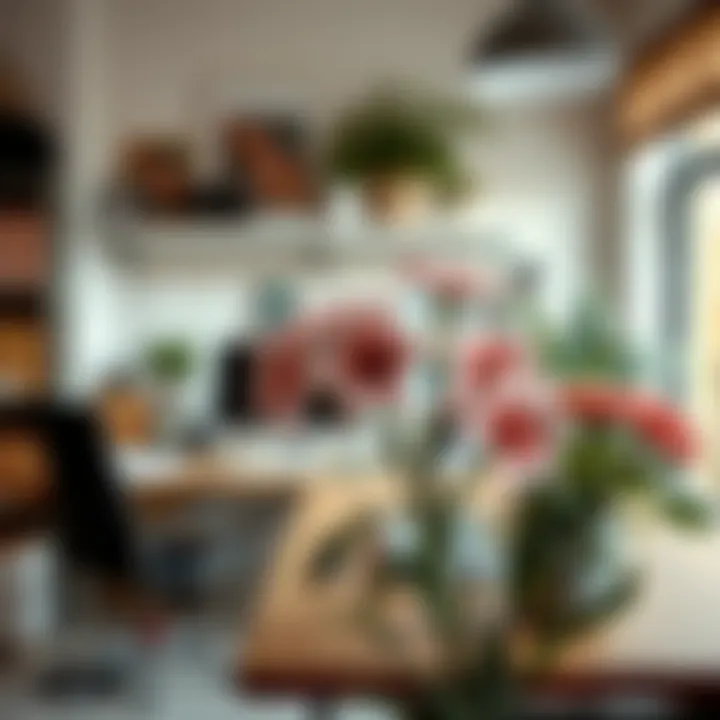
Every home has its own character, and selecting flowers that complement your style is essential. Whether it’s minimalist, traditional, or modern chic, there are artificial flowers to suit each of these styles. For example:
- Minimalist Designs: Opt for simple and clean lines. Feathery grasses or a single stem can harmonize beautifully without cluttering the space.
- Traditional Settings: Here, a mix of hydrangeas and peonies in soft hues might resonate well. They can exude elegance, often pairing well with classic furniture and ornaments.
- Modern Chic: Bold colors and exotic forms can add a flair to contemporary styles. Consider vibrant anemones cloaked in sleek vases.
Prioritizing flowers that fit seamlessly within your existing design can elevate the overall feel of your space, reminiscent of that curated look that both homeowners and designers strive for.
Size and Arrangement Considerations
Size doesn't just determine whether a flower looks good; it also affects the entire room's balance. Take into account the scale of your space and the proportions of other furnishings.
- Larger Flowers for Open Spaces: Big blooms or oversized arrangements could dominate a large living area, making a statement if done right.
- Small Flowers for Intimate Areas: Smaller arrangements are perfect for side tables or mantels, bringing a touch of life without overwhelming the space.
Arrangement Tips:
- Grouping: Cluster flowers in groups of three or five. It often creates a more dynamic and harmonious vibe.
- Use Vases Wisely: The height and shape of vases can dramatically influence your arrangement's appearance. Tall vases work well with long-stemmed flowers, while short bouquets often shine in compact containers.
- Test Before Committing: Sometimes it helps to try different arrangements before settling on a final look. Find the balance by testing in situ.
Taking these factors into account significantly aids in curating your space. Not only does it ensure that your selections are practical, but it also builds a cohesive design that’s both beautiful and functional.
"A flower does not think of competing with the flower next to it. It just blooms." - This saying captures the essence of selecting real artificial flowers. Take your time, and allow your spaces to express themselves.
Combining Real Artificial Flowers with Other Decor
Incorporating real artificial flowers into interior design is a nuanced art, much like finding the right spices for a dish. The key is in the combination. Rather than becoming mere accents in a room, these floral elements enhance the overall aesthetic when integrated thoughtfully with the surrounding decor. This synergy can create a harmonious environment, inviting both warmth and elegance into spaces. The importance of this combination lies in its ability to elevate a room’s vibe, creating a tailored look.
Integrating with Natural Elements
Bringing together artificial flowers with natural elements symbolizes a balance that complements modern decor themes. Using wooden accents or stone materials alongside real artificial blooms can bring out the best in both sides. Picture a sleek, contemporary kitchen where a bouquet of faux peonies sits beside a rustic wooden bowl; the contrast is striking yet fitting.
By adding greenery like succulents or small potted plants, artificial flowers can also seem less staged. This mixture blends organic and synthetic styles while enhancing the overall impact. The combination not only provides an inviting feel but also eases the burdens of maintaining real flora.
- Create a balance: Ensure the faux flowers have similar tones or textures to the natural elements.
- Keep it minimal: Too many decorations can overwhelm an area; focus on a few key pieces that resonate.
Utilizing Complementary Color Palettes
Colors have a unique language. Using complementary color palettes with real artificial flowers can turn your decor into a masterpiece. If you're working with a monochromatic scheme, introducing vibrant blooms can inject life and energy. Consider incorporating deep red roses against pastel shades for a rich, dynamic look. The visual impact can be significant, providing a focal point that draws the eye and ignites conversation.
- Understand color theory: Colors that sit opposite each other on the color wheel can enhance each other’s vibrancy. For example, pairing lush green leaves with bright pink flowers can create an invigorating atmosphere.
- Stick to themes: When theming a room—be it coastal, rustic, or modern—ensure your flower palettes align.
Creating Focal Points in Rooms
Focal points are like the cherry on top of a sundae—they grab attention and set the stage. Incorporating real artificial flowers to create an intentional focal point can dramatically transform a space. Think about placing a striking arrangement at the center of a dining table or on a shelf that draws the eye.
Supersized faux floral displays can command attention, while smaller clusters can guide the gaze around a room seamlessly. For instance, a single tall, elegant stem in a clear vase can invite admiration without overwhelming surrounding decor.
- Placement matters: Choose spots that naturally catch the eye; heights and angles can affect visibility.
- Balance is key: Avoid crowding the area; allow for breathing room around the focal point for maximum impact.
"The beauty of combining real artificial flowers with various decor elements is the transformative potential of harmonizing textures, colors, and themes."
By exploring the dimensions and depths of incorporating real artificial flowers with surrounding decor, one can not only beautify spaces but also create atmospheres that resonate with personal style. This deliberate integration is essential for anyone aiming to elevate their home or design environment.
The Environmental Impact of Real Artificial Flowers
The conversation surrounding the environmental impact of real artificial flowers has grown notably in recent years. As we ponder the sustainable options for home decor, understanding how these flowers contribute to eco-friendly choices is essential. With a keen awareness of both environmental concerns and aesthetic preferences, many homeowners and designers are steering toward these alternatives. Real artificial flowers present a range of benefits that can lessen our ecological footprint while still beautifying our spaces.
Sustainability Considerations
When focusing on sustainability, real artificial flowers often show a remarkable advantage. Unlike their organic counterparts, these flowers do not require water, sunlight, or soil, significantly reducing the resources needed for upkeep.
- Durability: Typically crafted from materials such as silk, polyester, or even recycled plastics, real artificial flowers can endure years without fading or wilting. This durability translates to less frequent replacements and a longer lifespan, making them a more sustainable choice in the long run.
- Manufacturing Impact: Advances in technology increase the efficiency of producing these flowers, using fewer chemicals and generating lower emissions compared to traditional floral farming that may rely on pesticides and fertilizers.
By choosing real artificial blooms, consumers engage in a more eco-aware lifestyle, contributing to a positive environmental impact without sacrificing elegance.
Waste Reduction in Home Decor
Using real artificial flowers can lead to significant waste reduction. Unlike fresh flowers that typically wilt and need disposing of within a short period, real artificial flowers promote a sustainable model of decorating.
- Less Frequent Disposal: These flowers don’t contribute to the organic waste piles that escalate in landfills. This longevity encourages their use in homes and offices alike, where they can be enjoyed for years.
- Reduced Packaging Waste: Flowers that are shipped fresh often come wrapped in plastic and foam for protection during transport. In contrast, purchasing real artificial flowers generally results in less packaging waste, contributing positively to environmental health.
Thus, each time a real artificial flower adorns a home, it signifies not just personal style but also a step toward responsible consumption and reduced ecological impact.
Comparative Analysis with Real Flowers
When weighing real artificial flowers against fresh ones, it's vital to consider several factors that reflect both environmental and aesthetic implications.
- Carbon Footprint: Fresh flowers often travel long distances from farms to retailers, incurring a notable carbon footprint due to transportation. In contrast, real artificial flowers are often manufactured locally, minimizing transport distances.
- Pesticides and Chemical Use: Fresh flowers may involve the application of chemicals harmful to the environment, whereas real artificial flowers are devoid of these substances.
While real flowers bring beauty and fragrance into the home, their downsides must also be acknowledged, particularly in regards to environmental impact. Real artificial flowers stand strong as a viable alternative, allowing homeowners and designers to accentuate their spaces while favorably impacting the planet.
"Choosing real artificial flowers isn't just a trendy decision; it's a conscious lifestyle choice that emphasizes sustainability and beauty."
In summary, the environmental impact of incorporating real artificial flowers into interior design is firmly grounded in sustainability, waste reduction, and their lower ecological footprint compared to fresh blooms. As we navigate the evolving landscape of home decor, prioritizing these elements can lead to increasingly sustainable choices in our environments.


Trends in Real Artificial Flowers
In the realm of interior design, trends ebb and flow, yet one constant presence is the embrace of artificial flowers crafted to look strikingly real. These florals are not just mere imitations anymore; they've become essential design elements within homes and commercial spaces alike. The rise in the use of real artificial flowers is indicative of broader shifts in consumer mindsets regarding sustainability, aesthetics, and practicality.
Current Market Trends
Right off the bat, one cannot overlook the monumental shift in consumer preferences toward environmentally-friendly products. Many individuals are now seeking sustainable options for home decor, making real artificial flowers particularly appealing. As the demand for unique, durable artifice flourishes, retailers have responded by stocking a diverse range of styles and designs that imitate their natural counterparts with remarkable accuracy.
Some trends to keep an eye on include:
- Eco-Friendly Materials: Manufacturers are increasingly using recycled materials and biodegradable substances to produce their artificial flowers, thereby minimizing environmental impacts.
- Customization: Consumers are turning to more bespoke options. Numerous providers now offer personalization in color and design, allowing buyers to curate arrangements that perfectly fit their aesthetic vision.
- Simplicity in Arrangement: Minimalist design is on the rise. As homes become more streamlined, simple yet elegant flower arrangements serve as subtle accents rather than overpowering decor elements.
Innovative Designs
Innovation within the industry is a game changer. Today's artificial flowers are often paired with artistic flair that goes beyond the conventional. Designers are layering textures and experimenting with colors in creative ways, leading to unique floral designs that resonate with contemporary tastes.
Some noteworthy innovations include:
- Textural Variety: Artificial flowers made from silk, polyester, or even lightweight foam provide different textures that bring a fresh feel to spaces. This variety strikes a balance between realism and artistry, offering a unique experience with each bloom.
- Dynamic Displays: Gone are the days when artificial arrangements were static. Innovative designers are creating flowers that can be rearranged or enhanced with technology, such as LED lights that bring arrangements to life, adding a whimsical charm.
- Nature-Inspired Patterns: Engaging in biodesign, many patterns reflect natural growth patterns, making them not just décor but also a conversation starter about sustainable choices in design.
Integration with Smart Design
As the world turns tech-savvy, the integration of real artificial flowers into smart design landscapes cannot be ignored. Interior designers are creatively embedding these flowers into their digital plans, leading to more cohesive and functional living spaces.
This integration involves:
- Smart Homes: With the rising trend of smart homes, flower arrangements can now incorporate sensors that adjust lighting or temperature to help maintain optimal conditions for the spaces they inhabit. This not only enhances the experience of the aesthetic but ensures that the environment feels inviting.
- Virtual Design Tools: Designers increasingly utilize augmented reality to simulate how different arrangements of artificial flowers might look within a space, allowing homeowners to make informed choices before committing to physical purchases.
In essence, the trends in real artificial flowers reveal much about our society's evolving relationship with nature and technology. As this field continues to bloom, it becomes increasingly important for designers, homeowners, and enthusiasts to pay attention to these changes. With innovation breathing new life into designs, real artificial flowers are here to stay, providing beauty and sustainability without compromise.
Caring for Real Artificial Flowers
In a world where aesthetics often dictate the atmosphere of a space, caring for real artificial flowers becomes not just a task, but an essential aspect of maintaining the beauty and longevity of your interior decor. Unlike their natural counterparts, real artificial flowers require specific care and attention, which ultimately allows them to maintain their vibrancy and realistic appearance over time. This section delves into the strategic methods to clean, store, and prolong the life of these decorative elements. By understanding the importance of proper care, homeowners, designers, and DIY enthusiasts can ensure that their investments in real artificial flowers yield the maximum visual impact.
Cleaning Techniques
Keeping your real artificial flowers looking fresh and lifelike is paramount. Missteps in cleaning can lead to dull colors or accumulated dust that detracts from their beauty. Here are effective methods:
- Dusting: Every so often, a simple dust with a soft cloth or a duster can keep them looking sprightly.
- Damp Cloth: For a deeper clean, use a slightly damp microfiber cloth to gently wipe the petals and leaves. It removes dirt without risking damage.
- Avoid Water Accumulation: Water can often seep into the flower's core, causing mold; use it sparingly.
- Use Mild Soap: If they need more than just a dusting, a solution of mild soap and water can work wonders. Just ensure to rinse and dry well.
Taking such care won’t just keep them clean; it will extend their lifespan significantly.
Storage Recommendations
When it comes to storing your real artificial flowers, a little forethought can go a long way. Here’s how to do it right:
- Temperature Control: Keep flowers in a cool, dry place. Excessive heat might warp or fade materials.
- Avoid Direct Sunlight: Prolonged exposure to sunlight can alter colors, making them look fake.
- Organized Boxes: Use clear bins or boxes for storage, which allows you to see what you have without needing to dig through everything. Wrap those delicate petals in tissue or paper to prevent any bending or breakage.
By following these simple guidelines, you'll maintain the integrity of your artificial flowers, ready for deployment in your design plans whenever you need them.
Longevity Practices
Real artificial flowers are a long-term investment, and a few longevity practices can ensure they continue to impress for years to come. Here are some practices that add on to the care already outlined:
- Rotate Your Display: Changing the placement or arrangement of your artificial flowers can prevent them from gathering dust in one spot and allows different areas of your home to benefit from their beauty.
- Avoid Heavy Air Fresheners: Use scented candles or essential oils instead of heavy perfumes around the flowers, as strong chemicals may diminish their appearance over time.
- Routine Check: Make it a habit to check your flowers regularly for wear and tear, and replace any discolored elements promptly.
The right practices not only maintain appearance but can also guard against any potential hazards related to the materials used in the flowers.
With proper care, real artificial flowers can remain a delightful addition to your interior spaces, offering consistent aesthetic pleasure without the hassle associated with live plants. By implementing these cleaning techniques, storage recommendations, and longevity practices, you can harness the full potential of real artificial flowers in your design endeavors.
The Future of Real Artificial Flowers
The future of real artificial flowers holds significant promise, particularly in the realm of interior design. As design trends ebb and flow, the incorporation of these aesthetically pleasing alternatives continues to gain traction. People are seeking ways to create inviting spaces without the commitment that comes with live plants. Real artificial flowers fit this bill quite nicely. Their durability, paired with ever-evolving design innovations, makes them a cornerstone for both contemporary and traditional interiors.
Emerging Technologies
Recent advancements in manufacturing processes have ushered in a new era for real artificial flowers. Thanks to cutting-edge techniques like 3D printing, manufacturers can now produce flowers that appear astonishingly close to their living counterparts. These technologies are refining not just the look but also the feel of artificial blooms. Materials are becoming more sophisticated, allowing for better flexibility and a more lifelike appearance.
Consider how sometimes gel-based substances mimic water droplets on petals, or color gradients evolve to replicate natural fading. This tech breakthrough enhances the realism of the flowers, making them even more desirable to designers and homeowners.
One noteworthy trend is the integration of smart technology. Imagine an artificial flower that can change colors or scents based on the time of day! With smart home systems gaining popularity, the prospect of intertwining artificial florals with home automation is a tantalizing consideration.
Market Predictions
Market predictions for real artificial flowers indicate a steady growth trajectory. Estimates show that the global market for these products is expected to grow significantly. With the rise in home makeovers and the increasing understanding of sustainability, consumers are gravitating toward alternatives that are both practical and aesthetic.
This shift is particularly noticeable in urban settings, where living spaces can be limited, and practical options are sought. Features such as low maintenance and long-lasting aesthetics make artificial flowers an enticing choice for busy city dwellers.
An analysis on industry trends suggests that retail avenues for these products will not only diversify but also align with current ergonomic and environmental demands.
Shifts in Consumer Preferences
The collective consciousness regarding home decor is shifting toward sustainability and practicality. Today's consumers want items that last without a steep price tag. The trend demonstrates a clear preference for durable products over disposable ones. Real artificial flowers are being embraced for their ability to provide lasting beauty without the waste associated with cut flowers.
A growing number of eco-conscious individuals are looking for decor that echoes their values. Real artificial flowers fit snugly into this ethos. Homeowners, designers, and retailers are increasingly recognizing that an investment in quality artificial flowers provides ongoing aesthetic value with minimal ecological footprint.
"In the age of sustainability, we must rethink our romance with nature, and artificial flowers emerge as remarkable allies."
All in all, as the aforementioned factors influence the market, the future for real artificial flowers looks bright. An era supporting innovative aesthetics, environmental sustainability, and practical solutions is at hand. Ongoing advancements combined with evolving consumer attitudes promise real artificial flowers a prominent place in interior decor for years to come.







